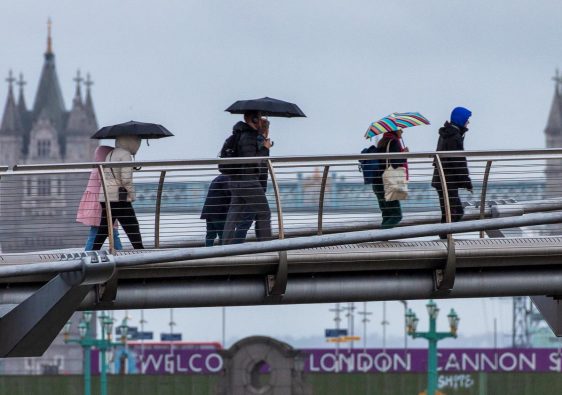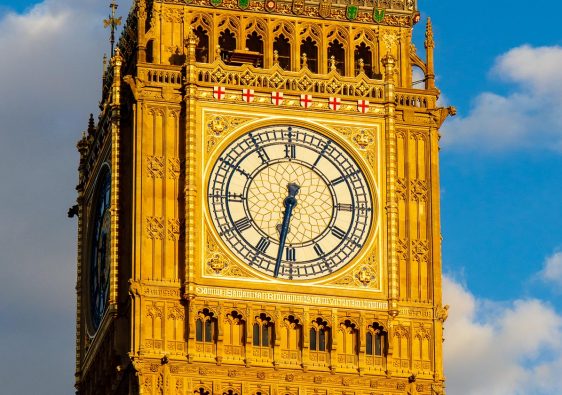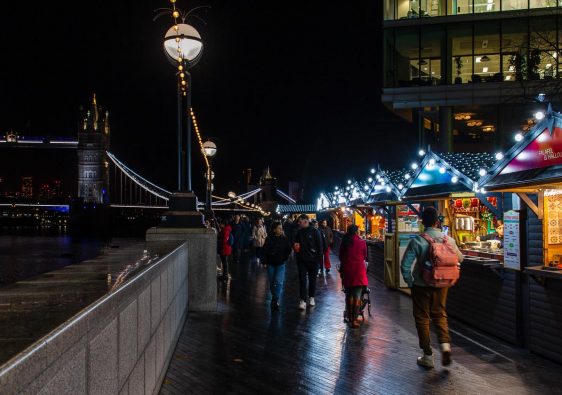The Tower of London is one of London’s most iconic and popular tourist attractions. With almost 1,000 years of history to explore, a visit here is highly recommended!
The Tower of London is a historic castle packed with tales of torture, imprisonments, hauntings and executions. During a visit, you’ll see everything from historic suits of armour to possibly the most famous jewels in the world.
There is a lot to see there though, and it can be quite daunting trying to figure out how to spend your day there. As a local, I’ve visited multiple times and have put together this guide to help share my knowledge.
Read on for my tips on how to make the most of your visit, from skipping the queues to how much time you should allow for a visit.
Contents
- What is the Tower of London?
- Can you go inside the Tower of London?
- Tower of London opening times
- How to book tickets for the Tower of London
- How to get to the Tower of London
- How to skip the queues at the Tower of London
- Things to see and do inside the Tower of London
- How much time do you need at the Tower of London?
- Tower of London tours
- Is it worth visiting the Tower of London?
- How accessible is the Tower of London?
- Food and drink at the Tower of London
- Tips for visiting the Tower of London
- Other places to visit near the Tower of London
- Pubs near the Tower of London
- Places to eat near the Tower of London
- Where to stay near the Tower of London
- Map of places to eat and drink near the Tower of London
What is the Tower of London?
The Tower of London is a historic castle and royal palace on the north bank of the River Thames. It’s an iconic symbol of England’s rich history, with origins dating back nearly 1,000 years to the Norman Conquest of 1066.
Commissioned by William the Conqueror, construction of the fortress began in the 1070s, built over the Roman city wall. This makes it one of the earliest Norman strongholds in England.
The first building was a simple wooden structure, however this was soon replaced by a stone structure in the 1080s. This was the White Tower – an impressive stone fortress that still stands today.
Over time, the tower has been adapted and developed with the additional of defensive walls, additional smaller towers and enlarging the moat.
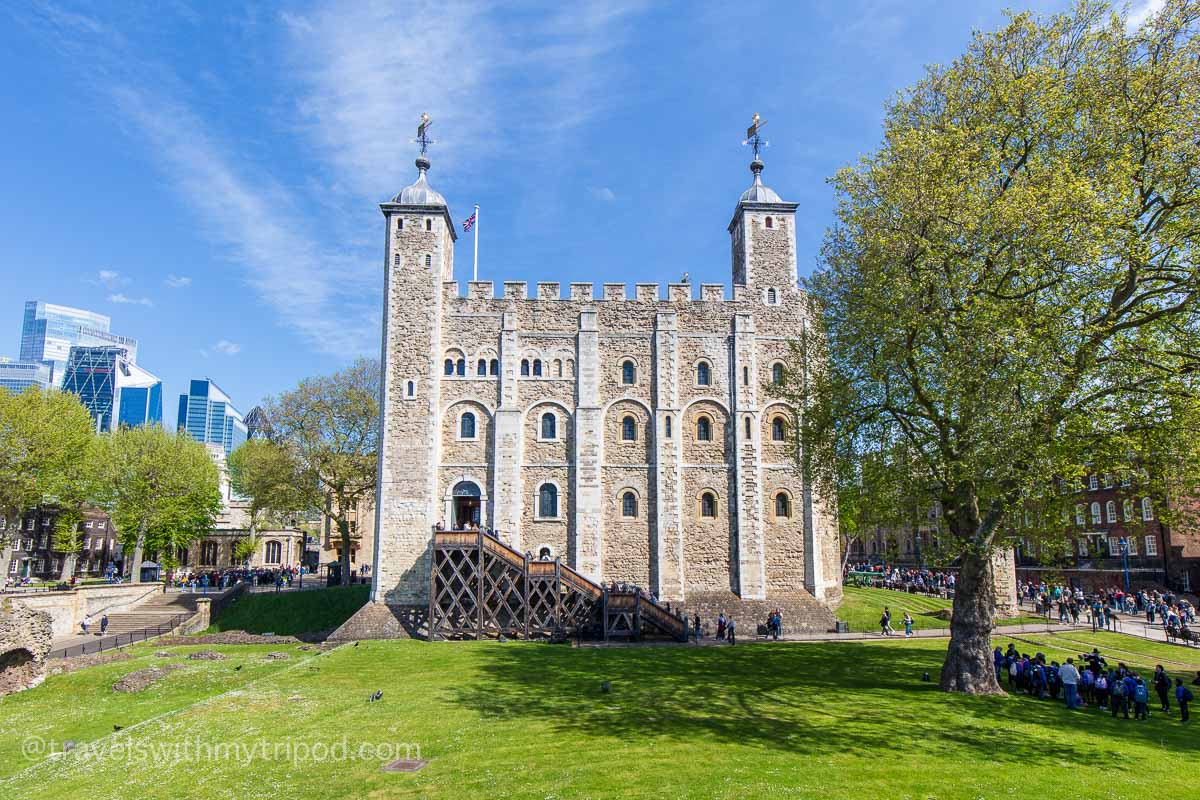
Initially built as a royal residence and defensive stronghold, the Tower had many uses over the centuries, serving as a royal palace, prison, royal mint, menagerie and armoury.
Over the years, the Tower played a pivotal role in shaping England’s political landscape, serving as the backdrop for numerous key historical events. It became notorious for its use as a prison, housing high-profile prisoners such as Anne Boleyn, Sir Walter Raleigh and Guy Fawkes.
The Tower has also witnessed dramatic royal events, including coronations, state trials and even executions. It was also the scene of one of the most intriguing murders in royal history, which is still being debated by historians today.
In addition to its political significance, the Tower of London became a symbol of royal authority and power, with its imposing structure and iconic White Tower dominating the London skyline.
Today, the Tower is a UNESCO World Heritage Site and one of the most popular tourist attractions in the United Kingdom, offering visitors a glimpse into more than a thousand years of British history.
Can you go inside the Tower of London?
Absolutely! Tourists can visit the site of the Tower of London and explore inside the White Tower, which is the stone fortress in the middle of the site. You can even see the world-famous Crown Jewels and other regalia that’s still used in royal ceremonies today.
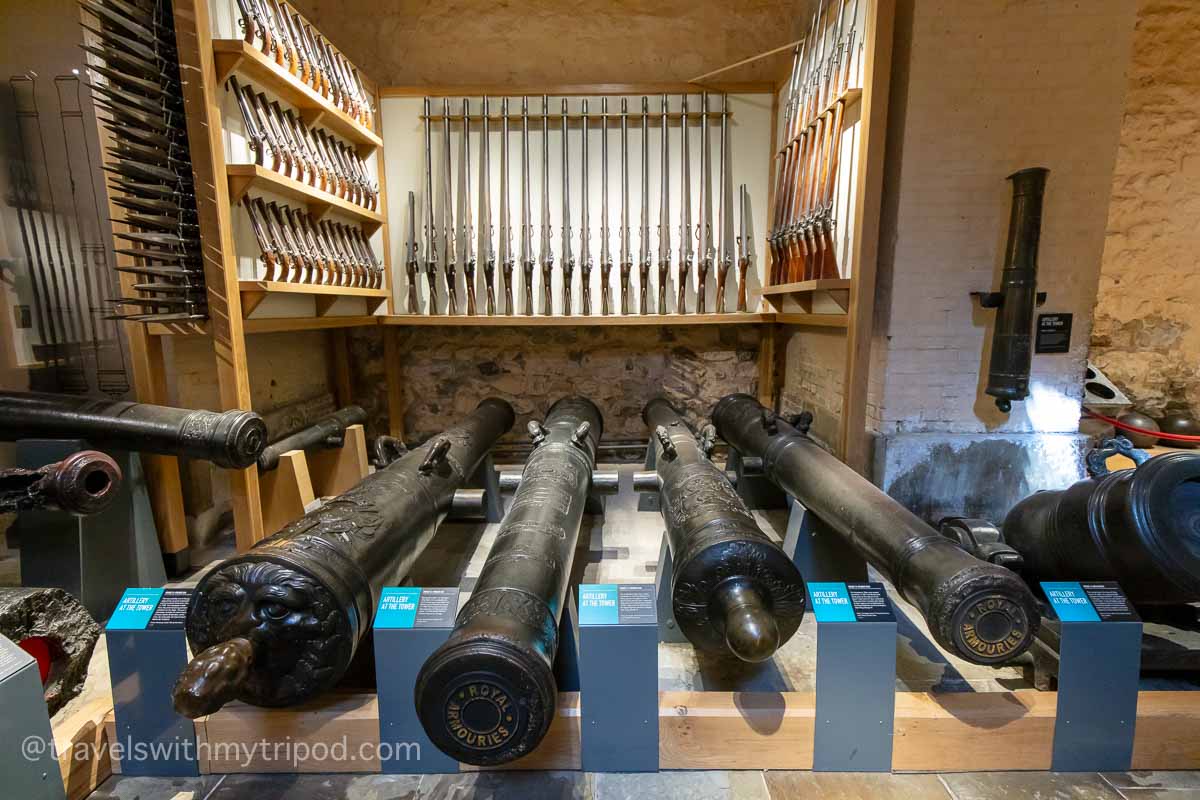
To explore this amazing piece of England’s history, all you need is a ticket and at least a few hours to spare.
Tower of London opening times
The Tower of London is usually open 7 days a week, although is closed on some days over the Christmas and New Year period. It has slightly different opening hours depending on the season:
Summer season (March – September)
- Tuesday to Saturday: 9:00 a.m. to 5:30 p.m.
- Sunday to Monday 10:00 a.m. to 5:30 p.m.
Winter season (October – February)
- Tuesday to Saturday: 9:00 a.m. to 4:30 p.m.
- Sunday to Monday 10:00 a.m. to 4:30 p.m.
During school holidays and half-term it opens at 9:00 a.m. on Mondays and Sundays rather than 10 a.m.
The last entry time slot is either 90 minutes or 2 hours before closing time depending on the time of year. The last Yeoman Warder (Beefeater) guided tour starts 2 hours before closing time, so bear this in mind if you’re planning to visit later in the day.
How to book tickets for the Tower of London
It isn’t free to visit the Tower of London (unless you’re a member of Historic Royal Palaces) so you will need to purchase an admission ticket. It isn’t part of the National Trust or English Heritage, so membership of these groups won’t get you free or discounted entry.
The standard entrance ticket gives you access to all the main areas which include:
The Crown Jewels, The White Tower, Chapel of St Peter ad Vincula, Battlements, Medieval Palace, Bloody Tower, Torture at the Tower exhibition, Fusiliers Museum and Royal Mint exhibition. Also included is a free guided tour by one of the Yeoman Warders, also known as Beefeaters.
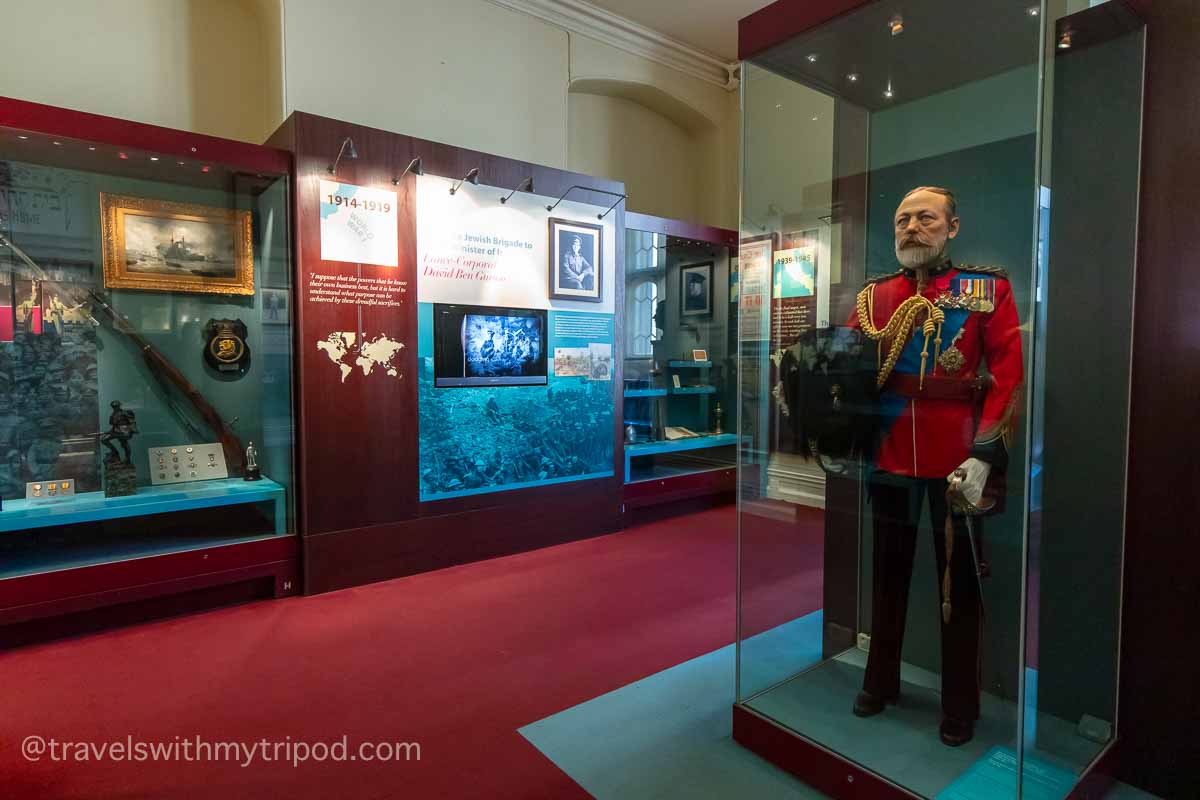
There are several ways you can buy a ticket for the Tower of London – either online in advance, or in person on the day. There are also ways to save money with 2-for-1 offers.
It’s worth noting that tickets don’t allow re-entry, so it’s not possible to leave and come back using the same ticket.
Online
The easiest way to buy tickets is to book online at the Tower of London official website. Here you simply select the date and time slot you would like to arrive. Tickets are available to book up to several months in advance.
At the ticket office
It’s also possible to buy tickets on-site at the main ticket office. At busy periods you may need to wait until the next available time slot, so it’s always recommended to book in advance to avoid disappointment.
How much are tickets?
As of May 2024, the cost of a ticket is as follows:
- Adult (aged 16-64) – £34.80
- Child (aged 5-17) – £17.40
- Concession (aged 65+, full time student, disabled visitors) – £27.70
- Child under 5 years – Free
- Universal Credit and other benefits – £1
- Resident of Tower Hamlets – £1
This isn’t particularly cheap, however given the amount of things to see at the Tower of London, I think it does offer good value for money.
If you live locally or are claiming Universal Credit or other benefits, you can get access for just £1! You just need to show proof of address or benefits at the ticket office when you purchase your ticket.
2 for 1 offer
If you are travelling into London by train you can get a voucher which enables you to get two tickets for the price of one. Simply request a voucher on the National Rail website and take a printed copy with you along with your train ticket. You’ll need to present these at the Tower of London ticket office on the day you visit.
This is only valid for tickets purchased in person so can’t be used when booking them online. This means you can’t book a date or time in advance, so at busy times you may need to wait until the next available time slot to get in. As such, I’d advise getting there early.
There are also some date exclusions which are detailed on the 2FOR1 website which basically cover New Year, Easter and the summer school holidays.
More details and link to download the voucher can be found on the National Rail 2FOR1 website.
London Pass
Entry to the Tower of London is included in the London Pass. Whether this pass is worth it really depends on how many other attractions you’ll use it for as it isn’t worth it just for entry to the Tower of London alone.
If you do have a London Pass though, simply join the Bought Tickets queue at the main entrance and have your pass ready to be scanned. It’s not possible to book a slot in advance with the London Pass, so at busy times you may be asked to wait until the next available time slot.
My advice would be to visit first thing on a week day to ensure you have the best chance of getting in straight away.
How to get to the Tower of London
Like most places in London, the quickest way to get there is by Tube (the London Underground subway system), but there are other options too.
It’s very easy to get to via public transport – either by road, rail or river!
Boat
There is a river boat pier (Tower Pier) very close to the main entrance of the Tower of London. This is served by Thames River Services from various piers including Westminster and London Eye.
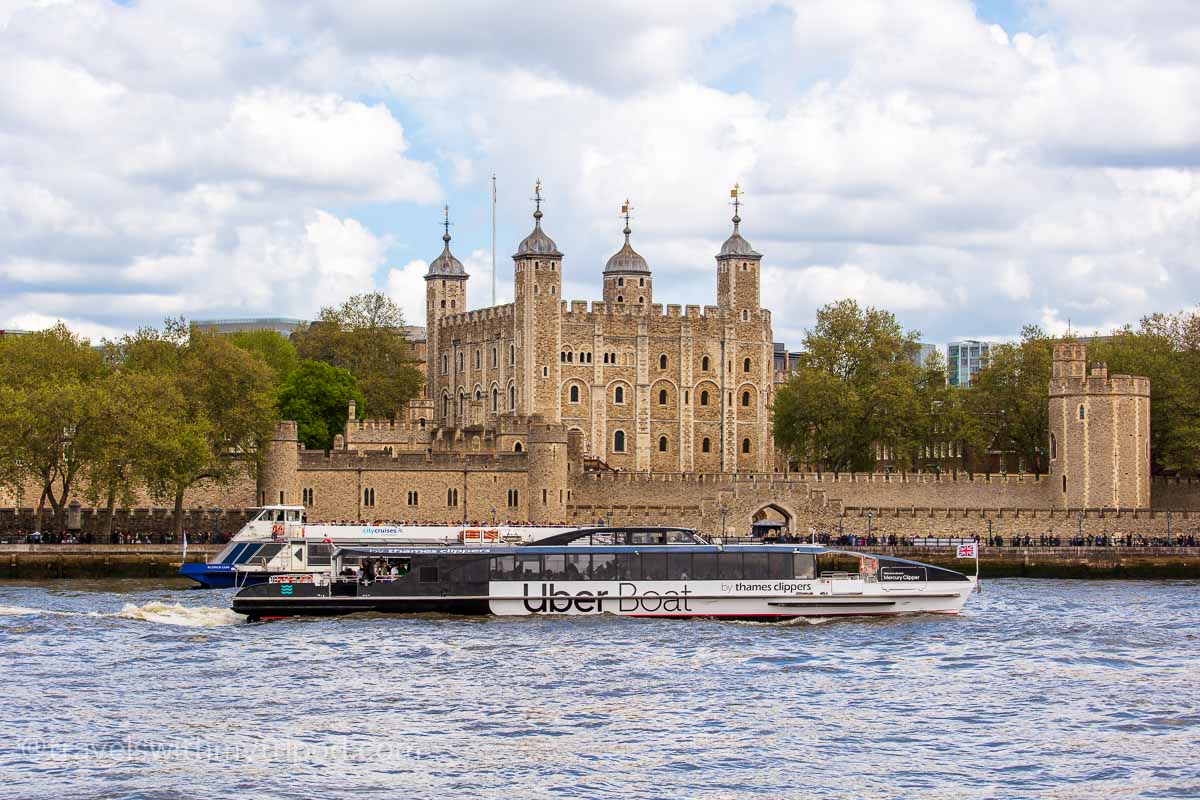
There’s another pier (London Bridge City Pier) slightly further away on the south side of the Thames. This is just past HMS Belfast and is served by the RB1, RB2 and RB6 services.
You can find more details, including timetables, here:
Bus
There are a number of bus routes that will get you to the Tower of London. Routes 15, 42, 78, 100, 343 and RV1 all are all served by stops very close by.
You can also get to the Tower of London via one of the Hop-on-Hop-off buses as these stop outside too. However using normal buses or the tube will be quicker.
Train or Tube (London Underground/Subway)
The Tower of London is close to two mainline train stations (London Bridge and Fenchurch Street) as well as two London Underground subway stations (London Bridge and Tower Hill).
London Bridge is served by the Jubilee (grey) and Northern (black) Lines. Tower Hill is served by the Circle (yellow), District (green) and Docklands Light Railway (turquoise).
If you get off at London Bridge, there’s a short 10-15 minute walk to get to the Tower of London, as you need to head north over the River Thames across Tower Bridge. The main entrance to the Tower is on the opposite side furthest away from Tower Bridge.
If you get off at Tower Hill, there’s a short 5 minute walk to the main entrance. This is to the right hand side of the Tower of London as you look towards the River Thames.
More details can be found on the Tower of London website or you can use the TFL Journey Planner.
Car
It is possible to drive to the Tower of London, however I wouldn’t really recommend it as traffic in London is so bad most of the time. If you do decide to drive, the Tower Hill Car and Coach park is located on Lower Thames Street just a couple of minutes walk away.
If you do take the car, you’ll need to pay the £15 Congestion Charge as the Tower of London is within the Congestion Charge zone.
How to skip the queues at the Tower of London
As one of London’s most popular tourist attractions, the Tower of London can be busy, especially at peak times. Not only are there usually queues to get in, but once you’re inside you’ll often have to queue for some of the attractions within the site, for example the Crown Jewels.
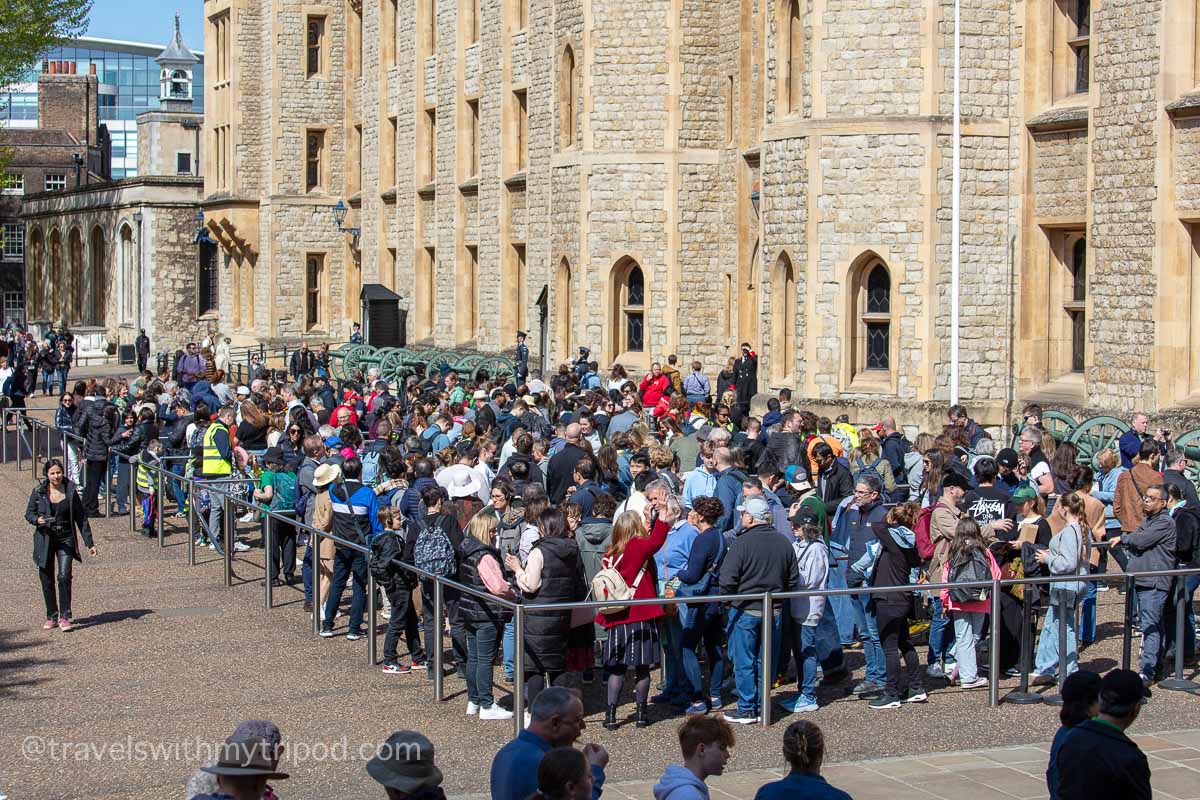
While some queuing is almost inevitable, there are a few ways you can avoid the worst with my tips:
1. Buy your tickets in advance
If you want to avoid queuing for the ticket office then the best option is to book your entrance tickets online in advance. This means you can go straight to the Bought Ticket line at the main entrance.
Unfortunately this won’t skip all the lines, as there is usually another queue here while they scan tickets and perform bag searches before you enter.
2. Avoid peak dates and times
The busiest times are in the afternoons and at weekends. It’s also busier during school holidays and the summer months between June and early September. So for the best chance of avoiding queues, I’d recommend going on a week day outside of the peak holiday season.
3. Get there early
The best time to visit to beat the queues is as early as possible in the morning. If you buy your ticket in advance you can select the first slot of the day. It’s also worth getting there about 30 minutes before the opening time, as that will get you to the front of the queue once they open the doors.
4. Visit the Crown Jewels first
The Crown Jewels display is the most popular and there can be a long queue to get in. At peak times this can be up to an hour. However if get there at opening time and head straight to the Crown Jewels, you’ll most likely be able to walk straight in without any queue at all.
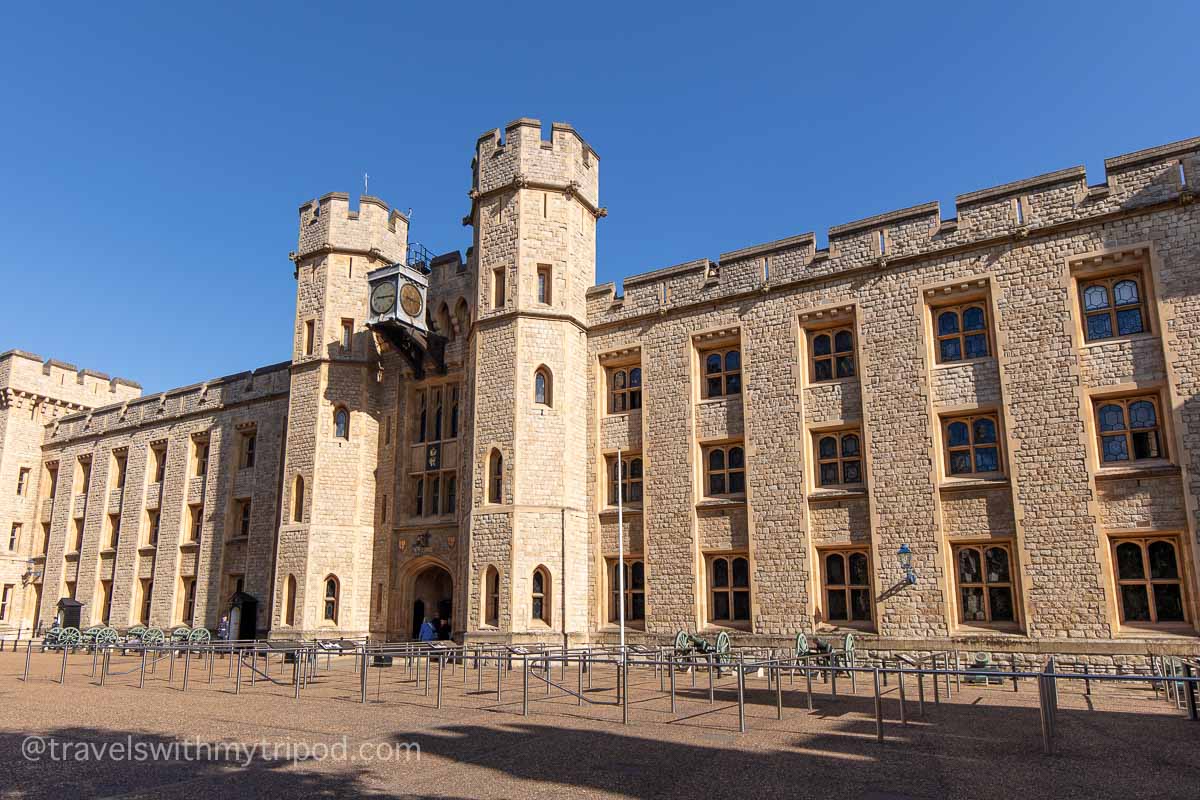
5. Pick the right entrance
For the majority of visitors, you’ll need to use the main West Gate entrance opposite the shop. However if you are part of a guided tour you will probably enter via the quieter group entrance which is on the south side of the tower near the river. Just head past the shop, along the banks of the Thames next to Tower Bridge to the Middle Drawbridge entrance.
6. Take a VIP guided tour
Some tour companies offer VIP guided tours of the Tower of London which include early access before the public. This is the easiest way to beat the crowds but these tours are relatively expensive. It’s also not possible to book these individually from the Tower of London directly so you will need to go via a tour company.
When booking, make sure that the guide is a certified Blue Badge guide as these are the only tour guides allowed to work within the Tower of London.
Things to see and do inside the Tower of London
There is a lot to explore at the Tower of London, all included in your admission ticket. The two most well-known attractions are the Crown Jewels and the White Tower, however there is plenty more to explore. This isn’t an exhaustive list, but here are some of my favourites.
At times, some areas might be closed for various reasons. For example, when I first visited, the chapel was closed for a wedding. If there’s anything specific you particularly want to see then I’d suggest calling ahead to confirm it’s open on the day you plan to visit. You can also check on the Tower of London website for details of any closures.
1. Be impressed by the Crown Jewels
The Crown Jewels are quite possibly the most famous and impressive display of jewels in the world. They have been stored and displayed at the Tower of London for many hundreds of years. A visit to the Tower of London wouldn’t be complete without seeing them!
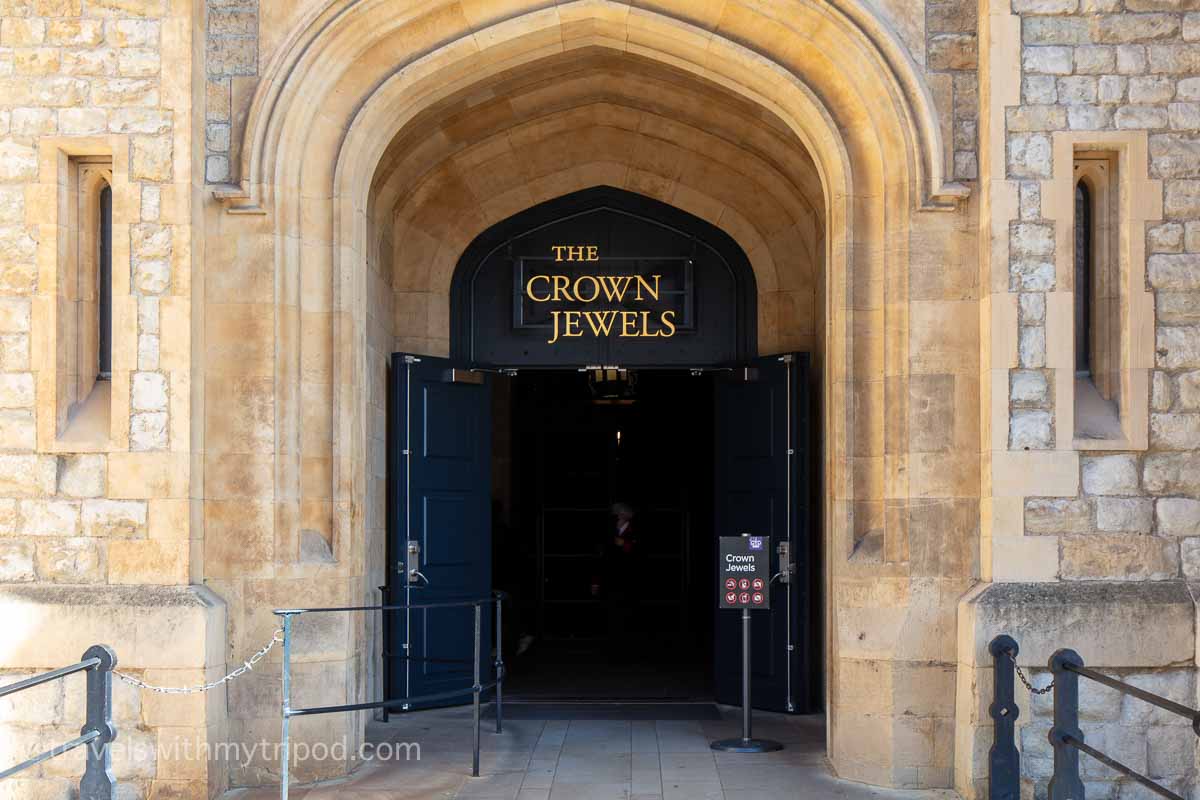
The Jewel House is located in the Waterloo Block which is in the northeast corner of the grounds, just behind the White Tower.
As you walk through the display you’ll discover the history of the jewels and discover how they are still used in royal ceremonies today. You’ll even get to see the actual crown worn by King Charles in his coronation in 2023, as well as items used for important national ceremonies such as the State Opening of Parliament.
2. Admire the displays of armour in the White Tower
Along with the Crown Jewels, visiting the White Tower is a must. Built almost 1,000 years ago, this iconic stone castle keep is the heart of the Tower of London.
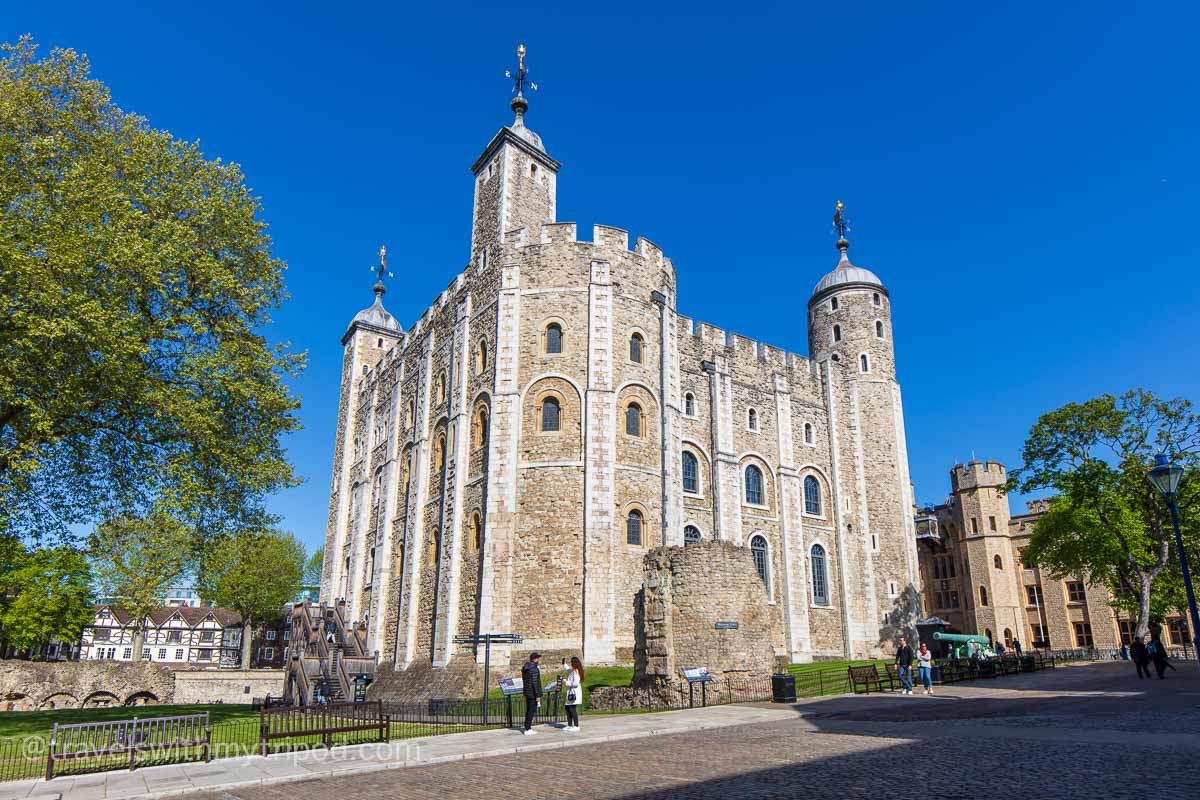
On entering the tower, you’ll first encounter the Line of Kings – one of the earliest museum exhibits in the world! This is an impressive display of the historic armour worn by kings such as Henry VIII and Charles I. There is also a line-up of life-size wooden horses wearing armour.
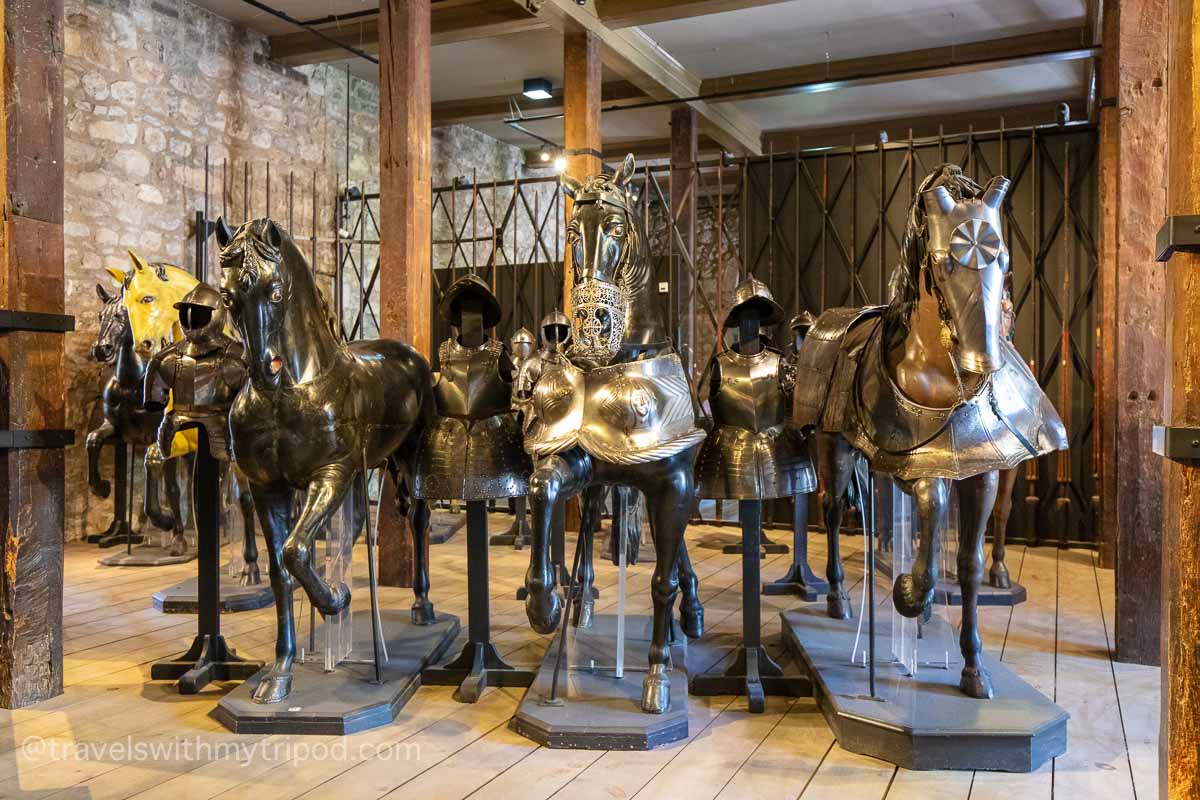
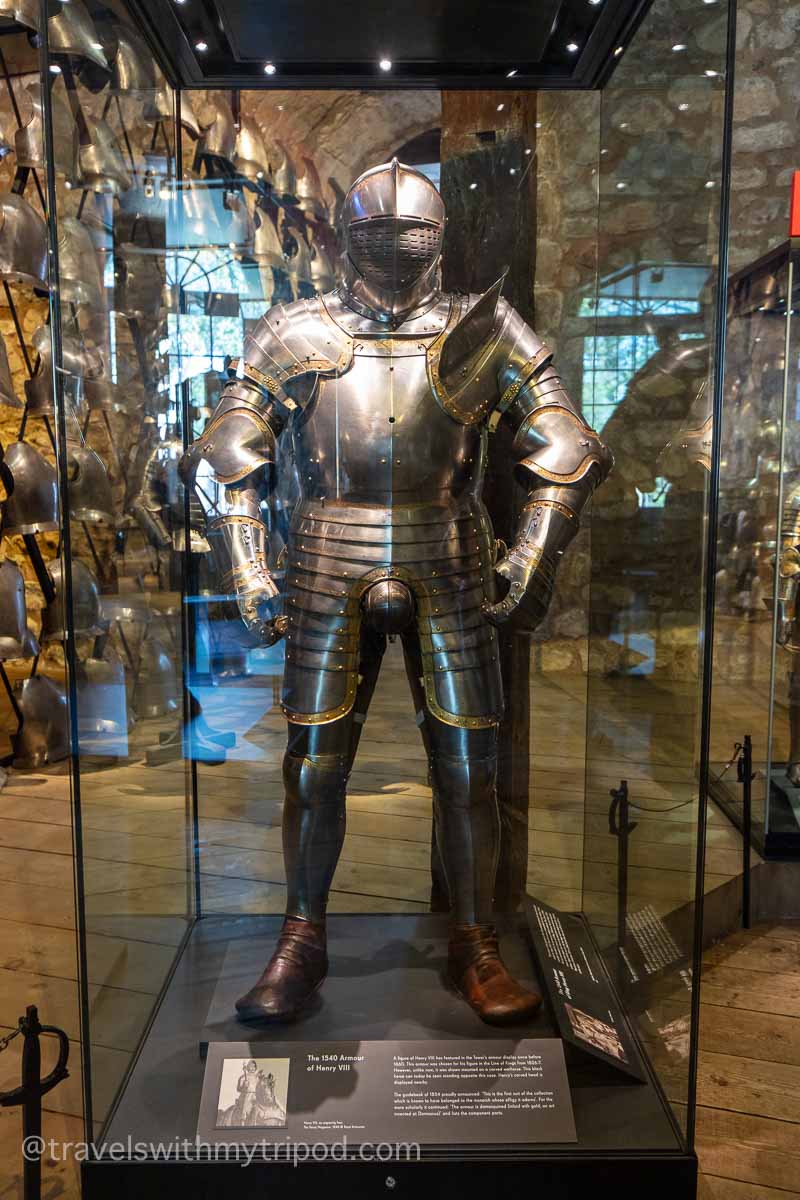
As you progress through the different levels of the tower, you’ll see historic artefacts such as an original executioner’s block. You’ll also get to visit St John’s Chapel, an impressive chapel where medieval kings and queens would have worshipped.
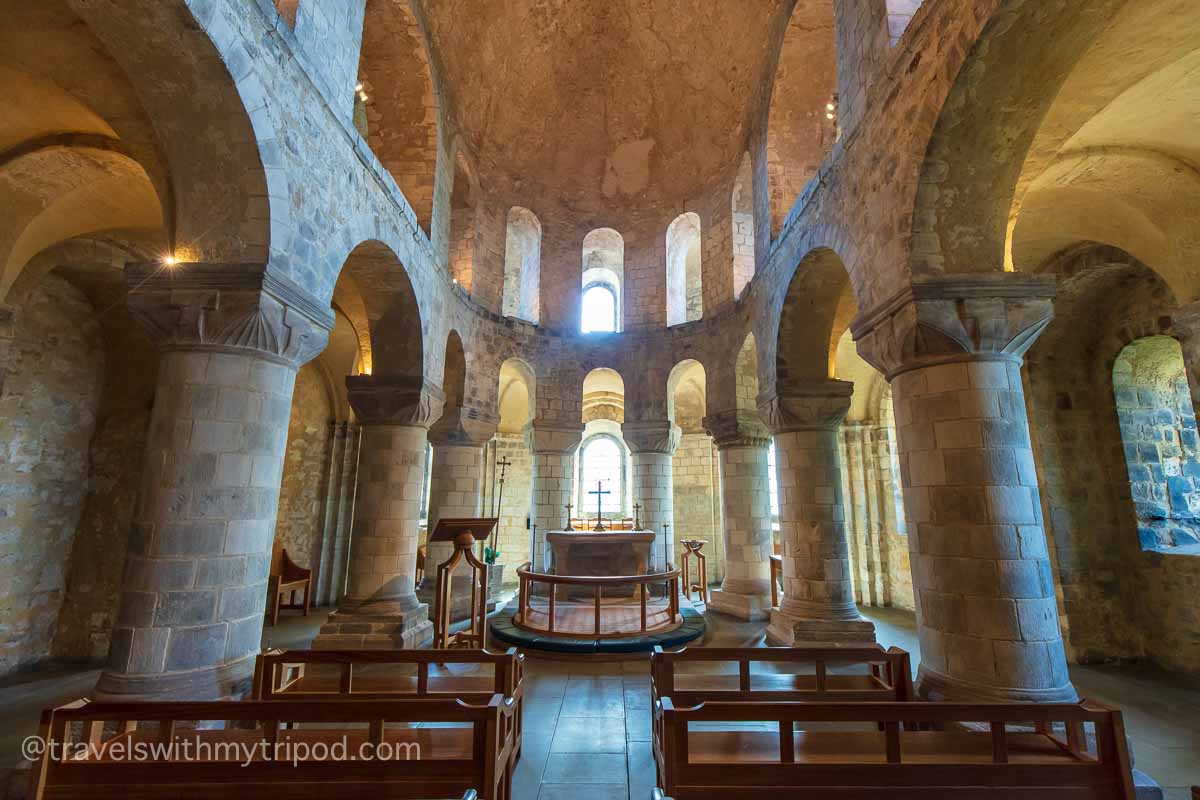
The tower isn’t all about looking at exhibits though – there are interactive experiences too, such as Armoury in Action. Here you can find out what it was like to shoot arrows and fire a cannon.
3. Walk around the battlements
A great way to explore many of the smaller towers and exhibits is to walk round the inner wall. From here you can enjoy great views towards the City of London from the north, and the River Thames and Tower Bridge to the south.
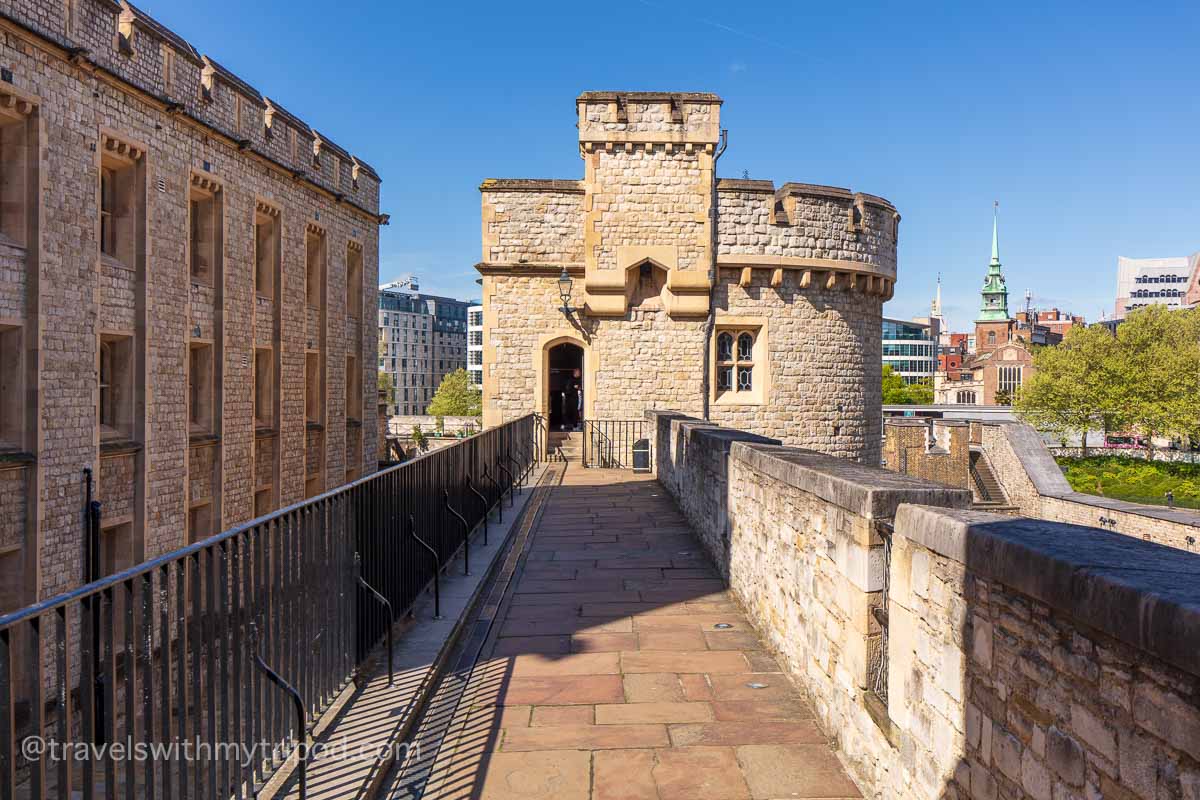
As you wander along the battlements you’ll be able to explore inside the defensive towers. Here you can discover more about the different roles the Tower of London has played over the years, right up to the 20th century.
4. Step back in history in the Medieval Palace
Located on the south wall overlooking the River Thames is the luxurious Medieval Palace. This contains impressive recreations of the plush interiors used by medieval kings and queens during their visits to the Tower.
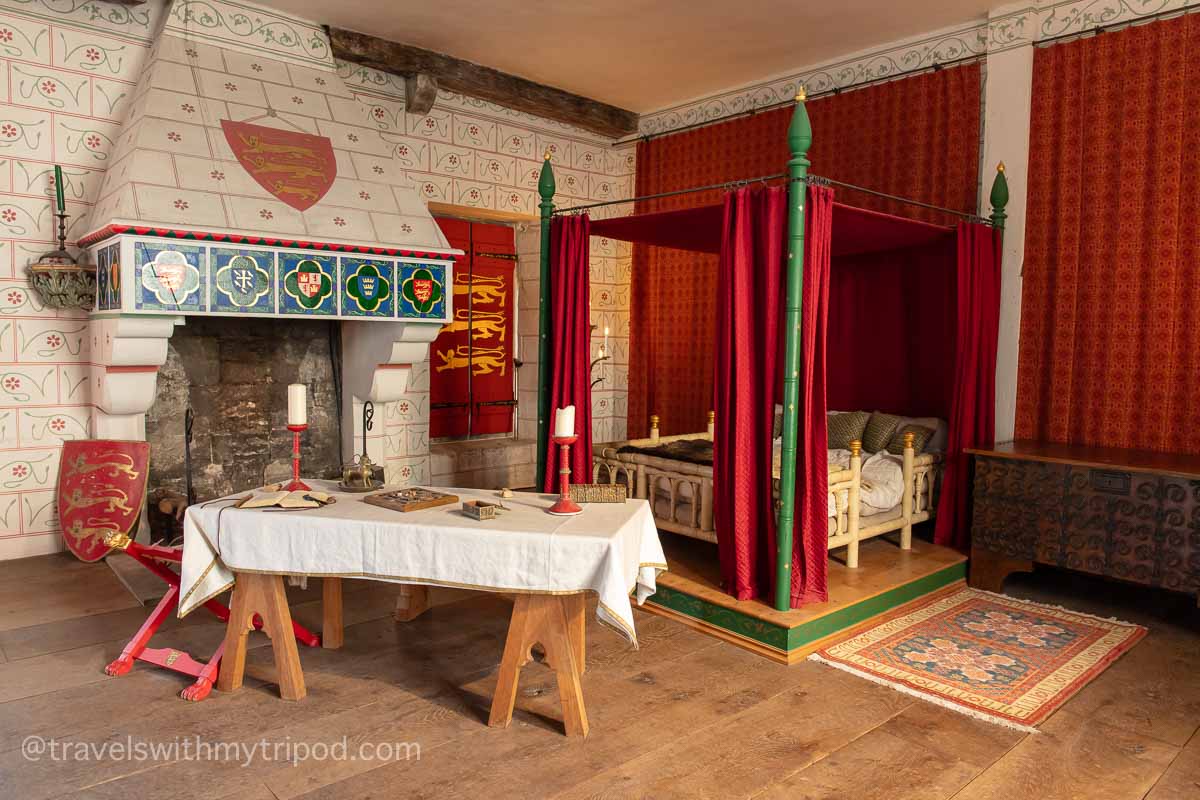
5. Spot the ravens and other animals
There are seven ravens currently living at the Tower, and these are an integral part of the Tower’s history. You’ll almost certainly spot them as you wander around – either in their lodgings on the South Lawn or as they explore the Tower grounds.
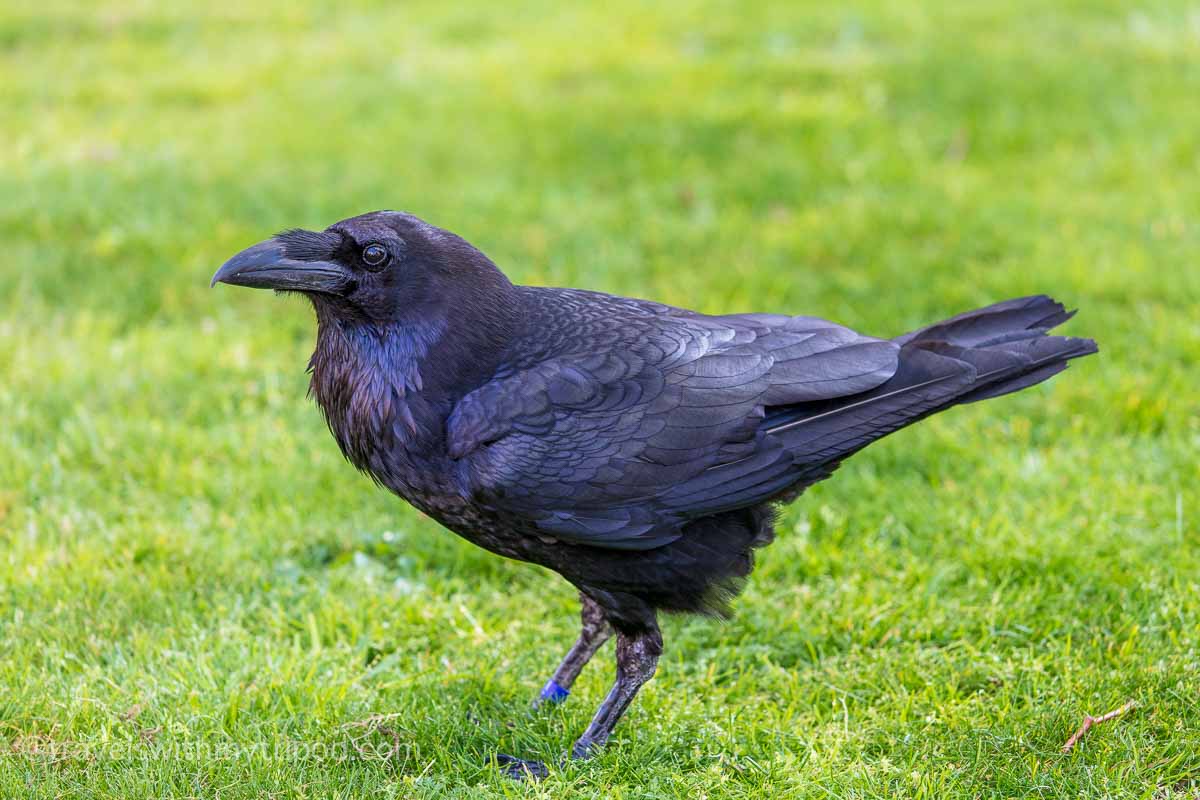
Legend has it that if the ravens were to leave, the Tower of London would fall. Fortunately this has never happened! You can learn more about the history and myths of the Tower’s ravens near their enclosures. While it might be tempting to get close to these impressive birds, please be careful and don’t approach too closely in case they bite.
As you explore the grounds, you’ll also discover how the Tower of London was the first zoo in London. From the 1200s to 1835 it housed a collection of wild animals including lions and an elephant . There was even a polar bear who was allowed to swim and hunt for fish in the River Thames!

6. See the guards and Yeoman Warders (Beefeaters)
During your visit, you’ll see two groups of personnel working together to protect the Crown Jewels and keep the Tower of London secure. The first is the Tower Guard who stand on duty outside the Jewel House and King’s House.
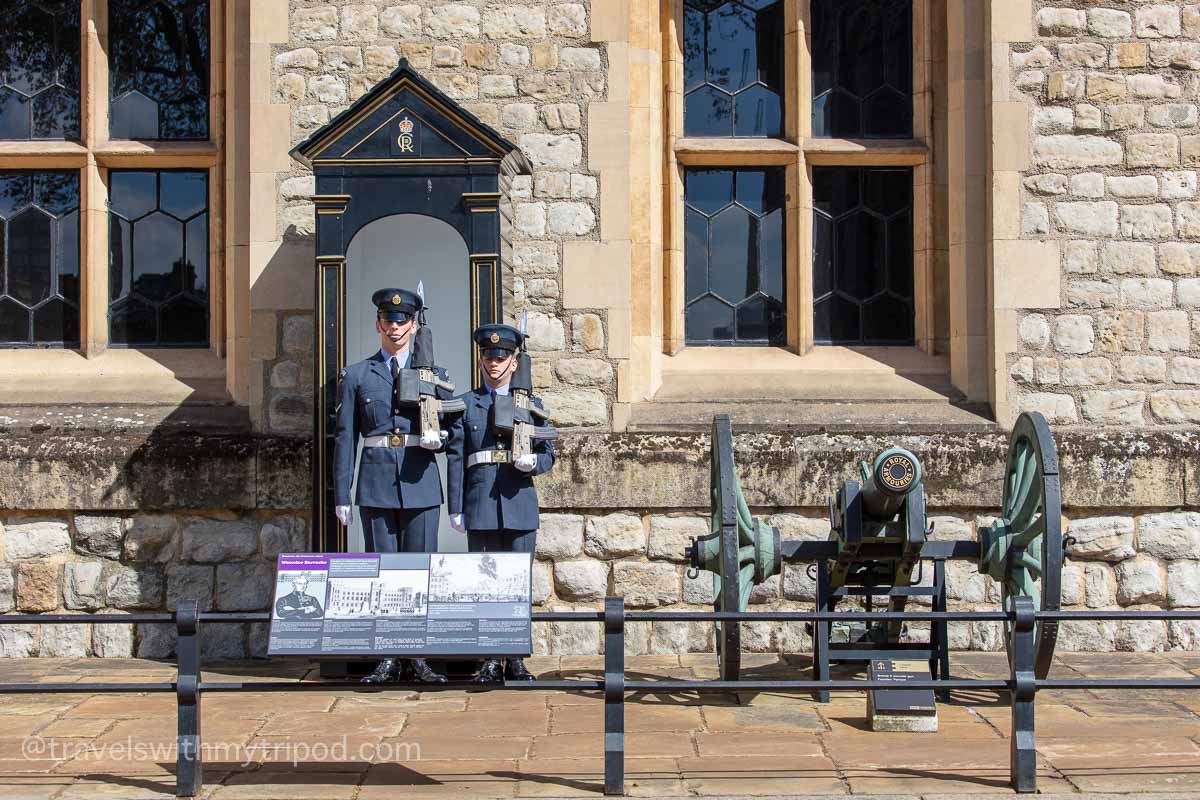
These are are serving military personnel, so keep out their way and be respectful when they are marching and performing their official duties. It is permitted to take photos of the Guards but they are not there to provide assistance to visitors so they won’t respond if you speak to them.
The Yeoman Warders are also from a military background having at least 22 years of service, however, unlike the Tower Guard, they are there to help visitors to the Tower. The Yeoman Warders are also happy to talk and answer questions about the Tower and even pose for photos if you ask.
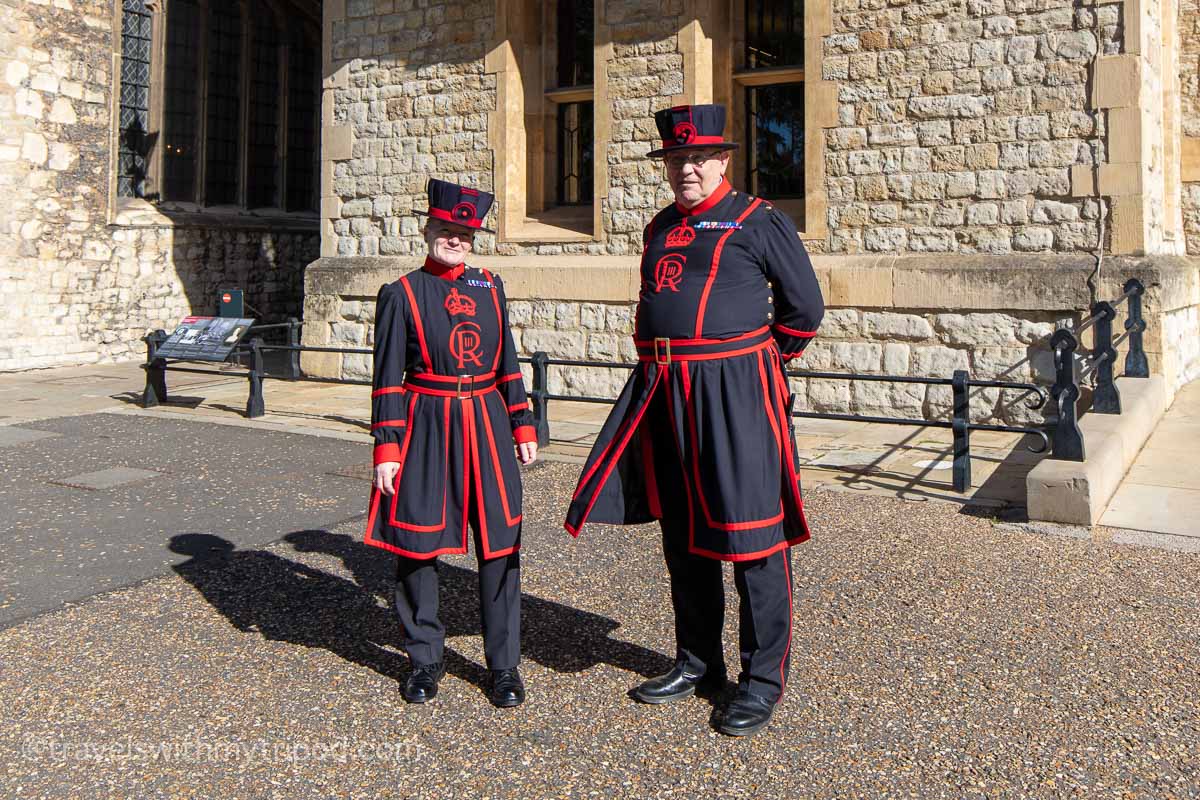
Both groups of guards also take part in three daily ceremonies at the Tower of London: the Ceremonial Opening, the Ceremony of the Word and the Ceremony of the Keys.
7. Visit the Chapel of St Peter ad Vincula
Tucked away in the northwest corner of the tower is the parish church of the Tower of London. It’s still an active church and holds regular religious services every Sunday. The chapel is also used for weddings so may occasionally be closed to the public.
It’s also where famous Tudors like Anne Boleyn and Thomas Cromwell were buried after being beheaded at the Tower.
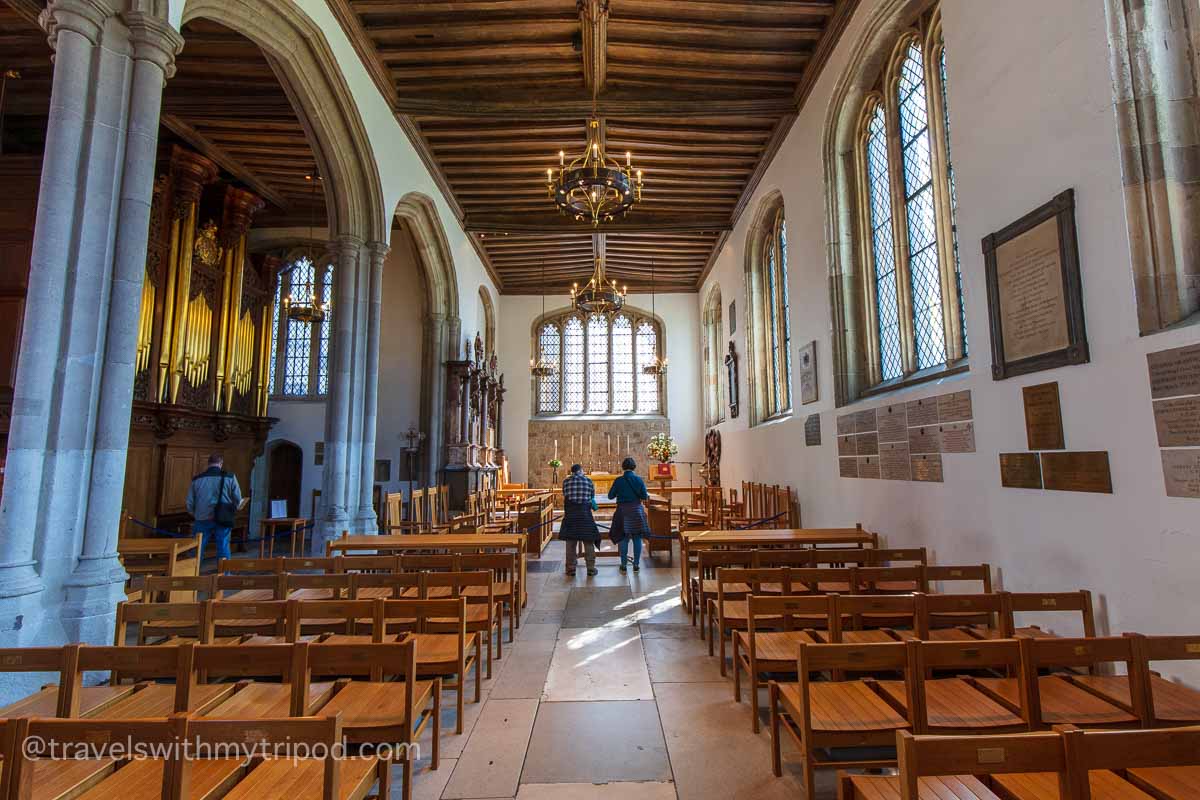
How much time do you need at the Tower of London?
If you’ve never been to the Tower of London before, you might be wondering how long does it take to see everything. Is 2 hours enough or do you need a whole day?
There is a lot to see at the Tower of London. With almost 1,000 years of history contained in an area covering 18 acres/7.3 hectares, there’s plenty to explore. It’s quite deceptive just how much there is to see there actually. It doesn’t seem that big when you look at it from the outside, but it’s deceptively large.
Also, if you go at busier times, you can spend a bit of time queuing for the more popular attractions. You can spend an hour just in the queue for the crown jewels if it’s very busy.
If you want to explore all the exhibits and read all the information displays then you can easily spend the whole day there. Based on my own visits I’d recommend allowing this amount of time for each section:
- Crown Jewels – 45 minutes
- White Tower – 1-2 hours
- Yeoman Warder (Beefeater) tour – 1 hour
- Walk around the battlements – 1 hour
- Bloody Tower – 15 minutes
- Medieval Palace – 20 minutes
- Torture room – 10 minutes
- The Fusiliers Museum – 20 minutes
- Chapel of St Peter ad Vincula – 15 minutes
It is possible to spend less time if you skip or rush round certain areas, but really you need at least 3-4 hours to do it justice. Plus, you should allow a bit of extra time if you’re planning to eat there or visit the gift shop.
Tower of London tours
While it’s perfectly possible to enjoy a visit to the Tower of London by yourself, you might want to take advantage of a guide to make more of your visit. There are several options, from a portable audio guide, to an organised tour with a qualified guide. Here are some options:
1. Audio guide
You can hire an audio guide for your visit, which costs £5 (£4 for concessions). This gives you 5 different tours to listen to as you wander around, adding to the experience. You can buy these on the day or order online in advance. Even if you order online, you still need to exchange the voucher for the audio guide on the day so this doesn’t really save any time.
The audio guides are collected from a small booth just to the right after you go through the main entrance.
At busy times, there can be a queue to collect audio guides. If this is the case I’d suggest collecting it a bit later in the day when the queue has reduced.
2. Yeoman Warder (Beefeater) tour
A Yeoman Warder tour is the perfect way to discover the history of the Tower of London. Even better, it’s included in the price of your entrance ticket! These tours begin every 30 minutes and start near the main entrance to the Tower. The tour lasts around 1 hour.
Yeoman Warders (or Beefeaters) have formed the Royal Bodyguard for well over 500 years and are now one of the most iconic symbols of London. They have also protected the Tower of London since the days of Henry VIII. These days, they must have served in the armed forces for at least 22 years and also been awarded the long service and good conduct medal.
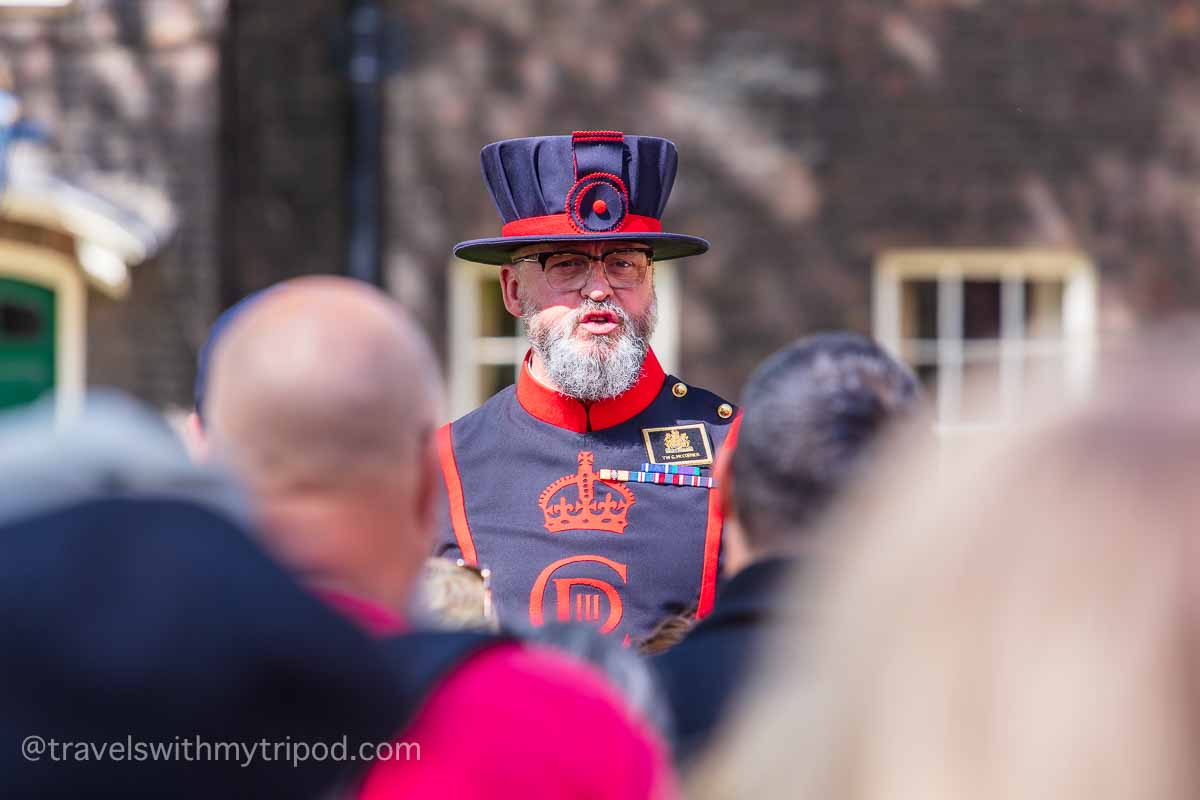
It’s thought that they gained their nickname from their position in the Royal Bodyguard which allowed them to eat as much beef as they wanted from the King’s table.
Your Yeoman Warder guide will share thrilling facts from 1,000 years of the Tower’s history as they take you around the grounds. The Beefeaters are all very knowledgable about the Tower’s history, as well as being entertaining and full of interesting stories.
These tours can be quite busy, especially at peak times, but they are very good at accommodating large groups.
3. Guided tour
If you want a more in-depth or personal guided tour then you can book a tour guide. These can either be booked directly with the guide, or via a tour company. The main thing to look out for is that the guide is a certified Blue Badge Tourist Guide.
Blue Badge guides have to study and pass exams to qualify, so you can be sure they know what they’re talking about. They are the only guides allowed to run tours inside the Tower of London.
Is it worth visiting the Tower of London?
I hope you’ll agree after reading about what you can see at the Tower of London that it’s definitely worth visiting! While the entrance fee is quite expensive, for that you get to spend a whole day discovering 1,000 years of London’s history.
It’s a fascinating place to visit and one of London’s iconic landmarks. You’ll also have the opportunity to see priceless royal regalia that is still used in ceremonies today.
How accessible is the Tower of London?
Much of the Tower of London is many hundreds of years old so access can be tricky for those with disabilities. There are narrow stairs and passageways, cobbled pathways and uneven ground.
Some displays such as the Crown Jewels have wheelchair access, however other areas such as the White Tower and Battlements walk are not wheelchair friendly. The White Tower alone has over 200 stairs, some of which are small and uneven.
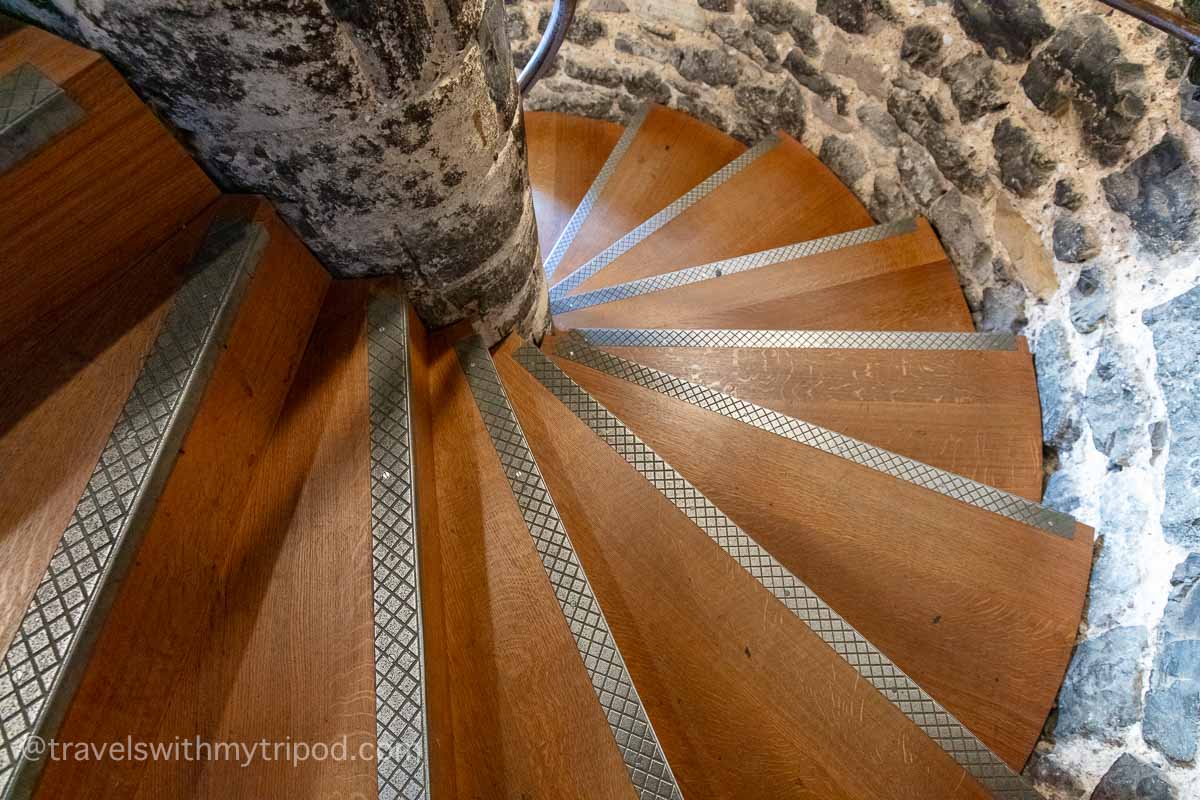
The Bloody Tower is probably the least accessible building as the staircase from the lower floor to the upper floor is very narrow and dark. Once you start climbing you have to continue, so isn’t ideal if you suffer from claustrophobia.
You can find out more details about accessibility on the Tower of London website.
Food and drink at the Tower of London
Once inside the Tower of London you’re not able to leave and come back in, so if you’re there for the whole day you’ll need to eat inside the grounds. Fortunately there are a few options:
Armouries Cafe
Here you can choose from a selection of sandwiches, snacks and hot meals as well as a variety of cold and hot drinks. It also has a large indoor seating area too. It can be busy at lunchtime, so you may prefer to eat a bit earlier or later to avoid the busiest times.
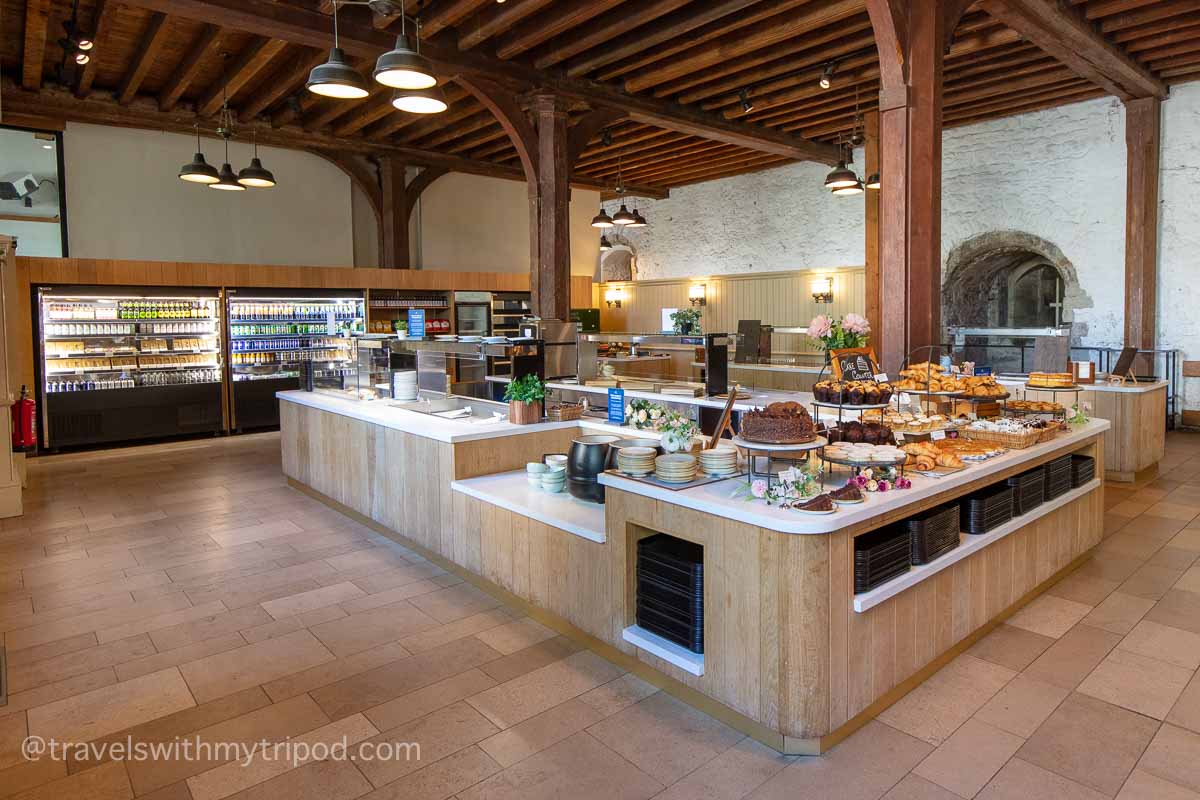
Also something to bear in mind is that there are no toilets inside the Armouries cafe. The nearest facilities are by the Cradle Tower. There is also a male toilet and accessible toilet next to the Salt Tower which is a bit closer.
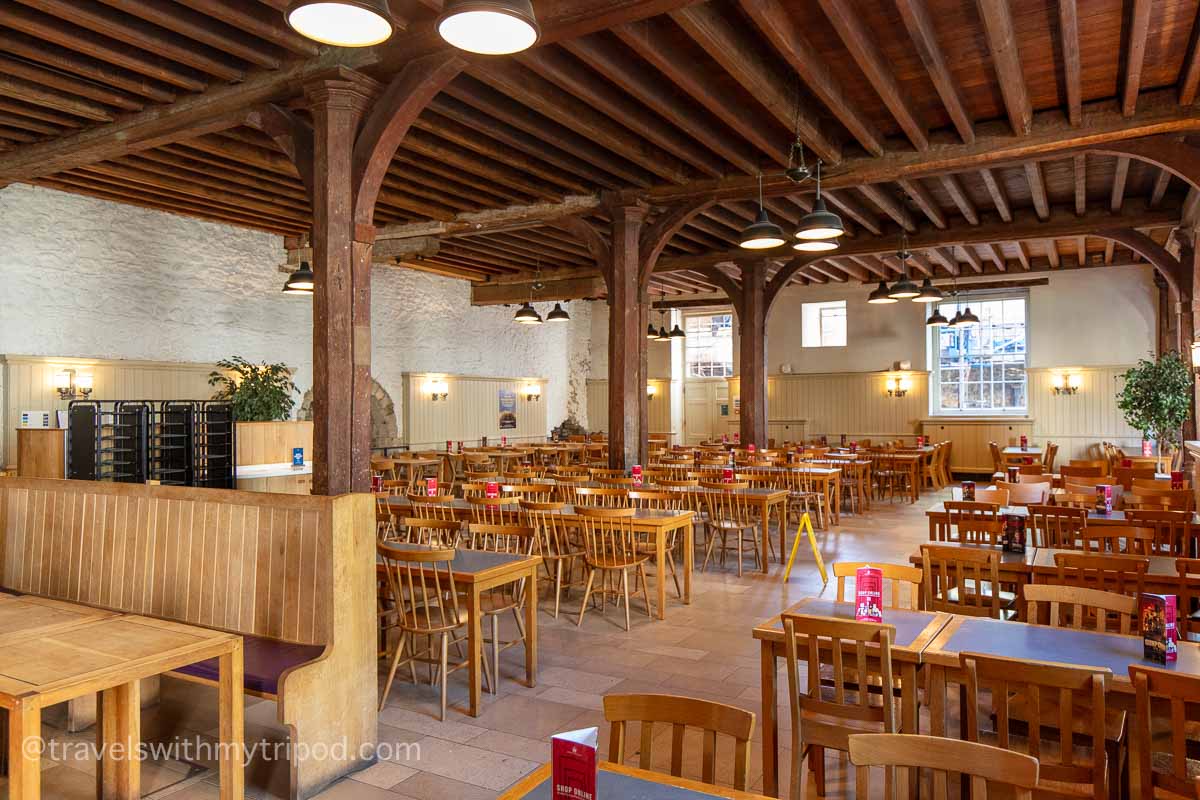
Ravens Cafe
Located near the raven enclosures, this stall sells hot dogs and cakes plus hot and cold drinks. There’s a small amount of outdoor seating.
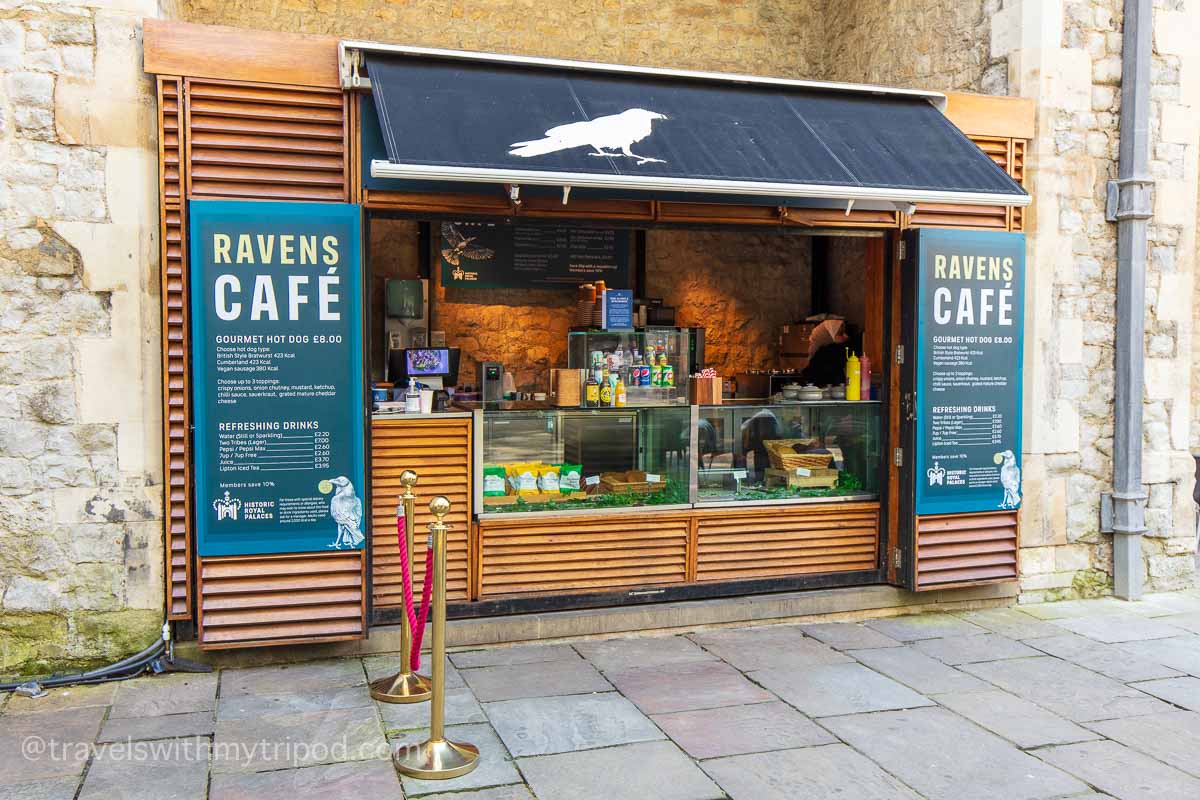
Bring your own picnic
If you’d prefer to bring your own lunch then you can bring a picnic with you to eat in the grounds. There are some benches located within the grounds where you can sit. Eating or drinking within any of the buildings is not permitted however, unless in designated areas.
Tower Wharf
Once you exit the Tower of London, there is another cafe and a few food kiosks just outside on Tower Wharf.
Tips for visiting the Tower of London
Here are a few of my tips for how to enjoy your visit to the Tower of London. If you have any of your own, please feel free to add them to the comments below!
Photography at the Tower of London
It’s possible to take photos almost everywhere within the Tower of London. The only exception is within the Crown Jewels exhibition where photography is strictly not permitted.
Tripods and selfie sticks are not allowed either.
What clothes to wear
There is a fair amount of walking involved in visiting the Tower of London, with uneven cobbles and stairs to contend with. I’d recommend a pair of comfortable walking shoes or trainers.
While much of the exhibits are inside, there is still plenty to see outside so I would recommend dressing for the conditions and taking a waterproof jacket if rain is forecast. During the colder months, the interiors of the buildings can be quite cold too.
Wi-Fi
The Tower of London does offer free WiFi, however in my experience this isn’t always that fast or reliable.
Buggies, pushchairs and luggage
While buggies and pushchairs are allowed in the grounds, they aren’t permitted inside the White Tower. There are a couple of free buggy parks where they can be left.
You are allowed to carry a small bag or rucksack with you, but anything larger than cabin baggage size won’t be allowed. There are no left-luggage facilities at the Tower so you’ll need to find somewhere else to leave large bags.
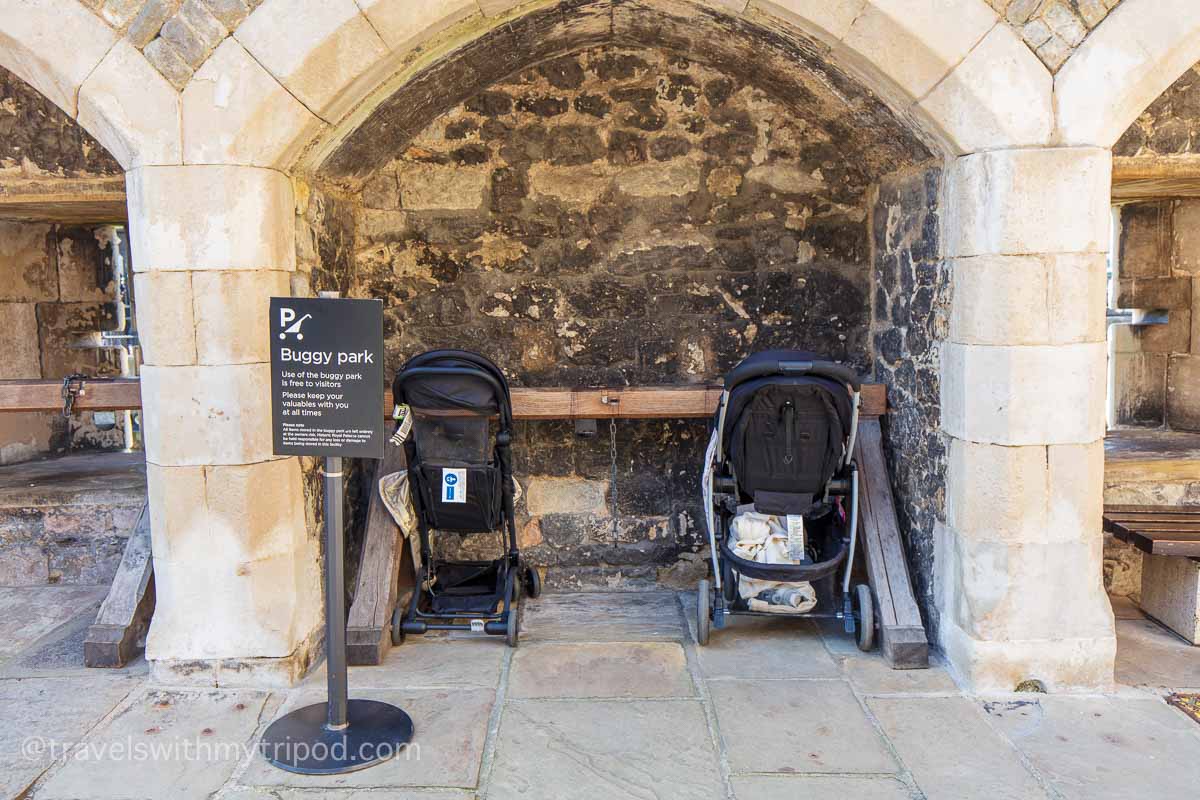
Souvenirs
There are several gift shops within the Tower of London as well as the main one just outside the main entrance.
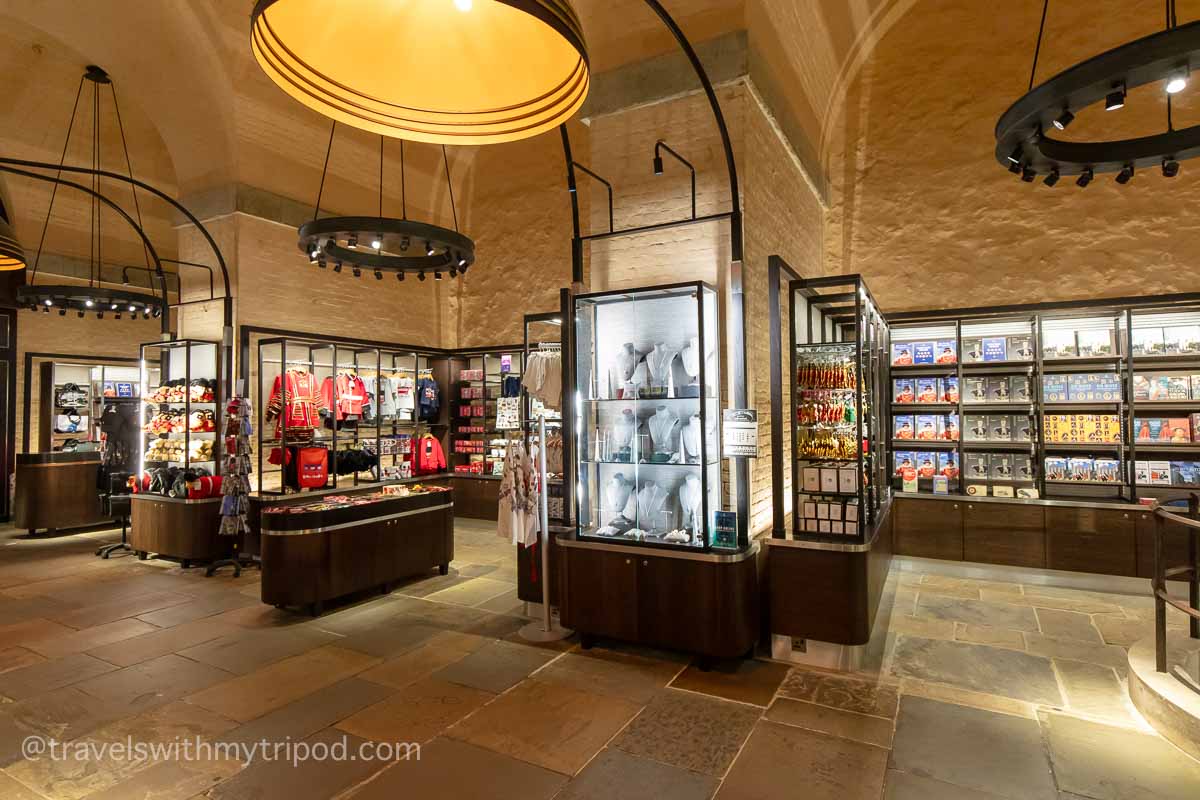
Other places to visit near the Tower of London
There are many things to do near the Tower of London – enough to keep you busy for several days at least. Here are some of my suggestions:
- Visit Tower Bridge
- Have a drink while admiring the views from the top of the Sky Garden
- Explore WWII ship HMS Belfast
- Walk along the River Thames Path
- Take a boat tour to Greenwich
- Wander around St Katherine Docks
- Visit London Bridge Experience (this is near London Bridge station, and not to be confused with the Tower Bridge Experience)
- Check out Southwark Cathedral – London’s oldest Gothic church
- Sample some of the tasty treats on offer at Borough Market, one of the largest and oldest food markets in London.
- Climb the 311 stairs to the top of The Monument – a 202 feet tall tower commemorating the Great Fire of London.
Pubs near the Tower of London
If you fancy a pint or some proper pub grub to eat, there are a few pubs nearby that I recommend. I’ve created a map at the bottom of the page with locations of all of them.
- The Dickens Inn, St Katherine Docks – a reconstructed 18th-century timber-framed warehouse overlooking the marina. It serves decent food, and has a large beer garden.
- Prospect of Whitby, Wapping – a historic river-side pub. It’s a bit of a walk from Tower Bridge – around 20 minutes, but if you’re after an authentic old London pub with lots of history then it’s worth the effort. You’ll also walk past two other pubs worth visiting on the way as you wander along the cobbled streets of Wapping – Town of Ramsgate and The Captain Kidd.
- Dean Swift Pub – a small pub tucked away in a quiet back street in Shad Thames. It’s only a short walk across Tower Bridge, but it’s far enough away to be hidden from all the crowds.
- The Vault 1894 – a small pub located directly underneath Tower Bridge on the south side. If you’re lucky, you’ll be able to get one of the window seats overlooking the river.
- All Bar One – a decent quality chain pub located just a few minutes walk away from the Tower.
- The Walrus And The Carpenter – a traditional pub that serves traditional pub food classics.
Places to eat near the Tower of London
There are plenty of places to eat in the vicinity. Here are some of the cafes and restaurants I would recommend. You can see where they’re all located in the map at the bottom of this page.
- Coppa Club Tower Bridge – located near the main entrance. You can eat inside, on the terrace, or even book your own cozy igloo with stunning views of the river!!
- Gaucho Tower Bridge – if you’re in the mood for Argentinian steak, this is the place to go! Located on the opposite side of the river, on the way to London Bridge station.
- Ivy Tower Bridge – a good quality brasserie located next to Potters Field Park, and with views of Tower Bridge and the Tower of London.
- Butlers Wharf Chop House – a good quality steak restaurant overlooking the Thames. You can sit inside, or enjoy an outdoor heated terrace for the ultimate river views. They also serve an excellent Sunday Roast!
- Le Pont de la Tour – a classic French restaurant next door to Butlers Wharf Chop House.
- WatchHouse – a coffee shop located just a few minutes away down the cobbled streets of Shad Thames. They serve great quality pastries as well as other snacks.
- The Coal Shed – another good quality steak restaurant just a few minutes away on the opposite side of the river. You will usually need to book in advance.
- St Katherine Docks – there are a selection of restaurants just a few minutes walk from the Tower of London in this picturesque marina.
- Borough Market – choose from a selection of food stalls at this famous food market about 10-15 minutes minutes walk away.
If you’re just looking to just grab something quickly, there is a mini Tesco supermarket nearby. This is located just to the left as you exit underneath Tower Bridge.
Where to stay near the Tower of London
While the Tower of London is very easy to get to via public transport, if you decide you want to stay nearby there are a number of hotels within a few minutes walk. Here are some of the closest:
- The Tower Hotel – St Katharine’s Way, London E1W 1LD
- hub by Premier Inn – 28 Great Tower St, London EC3R 5AT
- citizenM Tower of London hotel – 40 Trinity Square, London EC3N 4DJ
- Tower Suites by Blue Orchid Hotels – 100 Minories, London EC3N 1JY
- DoubleTree by Hilton Tower of London – 7 Pepys St, London EC3N 4AF
- Novotel London Tower Bridge – 10 Pepys St, London EC3N 2NR
- The Lalit London – 181 Tooley St, London SE1 2JR
- Apex City of London Hotel – 1 Seething Ln, London EC3N 4AX
Map of places to eat and drink near the Tower of London
How to use this map: Click on the icon in the top-left corner of the map to reveal a list of locations. If you click on one of the locations in the list, or one of the pins on the map, you can get more information or directions to it.
Click on the star just to the right of the title to save to your Google Maps account. You can then view the map on your phone or computer by opening Google Maps, clicking the “Saved” icon and then selecting Maps. You’ll then see this map in your list.

